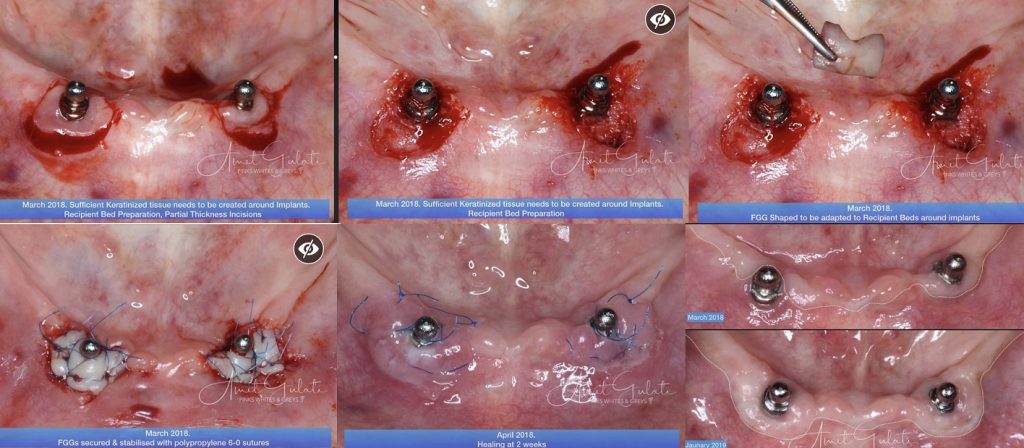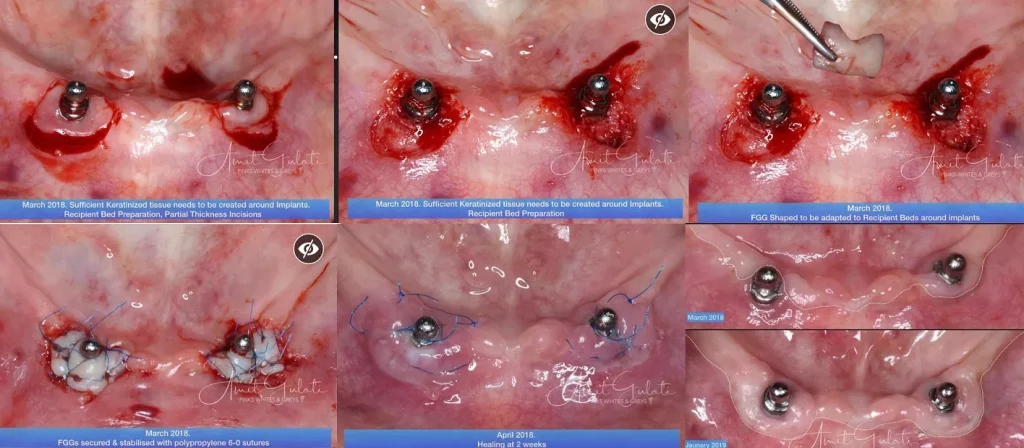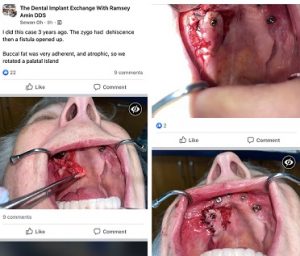What are the options for a gum graft around dental implants?
Gum graft around dental implants are something we do to increase the amount of healthy thick keratinized tissue. This may be more ideal to do before a dental implant.
When is a gum graft around a dental implant beneficial?
Although there is some debate on the issue, many believe thick keratinized tissue is beneficial to healthy long term problem and pain free survival of a dental implant. There is some research that keratinized tissue decreases the risk for peri-implantitis.
What kinds of grafts do we use?
The two most common types of graft to gain keratinized tissue are a free gingival graft and a collagen matrix graft. The procedures are basically the same. The advantages of the collagen is no donor site and no limitation in amount available. The disadvantages are that there will be less gain consistently so must overdue the surgery. A common collagen for this type of procedure is Mucograft.
What are the best steps for a gum graft around a dental implant in the mandible?
The best technique seems to be a split thickness apically repositioned flap with either a free gingival graft or a sub-epithelial connective tissue graft.

- Split thickness flap
- Suture flap apically
- Harvest gingival graft or place Mucograft
- Suture that in place
What are the best steps for a gum graft around a dental implant in the maxilla?
On the palate you can do a buccally displace the flap and go more palatal with the incision. This is a split thickness incision. Testori IJPRD 2022
You can also do a palatal rotational flap around the dental implant.
When can we do a gum graft for a dental implant?
The best time to increase the quantity of healthy thick tissue is before we place a dental implant. However, that doesn’t always happen and sometimes we need to do that grafting after.
Other options to gain keratinized tissue around a dental implant
There are many ways to increase tissue with grafting. The free gingival graft and the apically repositioned flap are the most common methods. Often a kind of combination of the two with be the ideal treatment.
Technique to add keratinized tissue to a dental implant
There are many times where we want or need more keratinized tissue around a dental implant. If we discover this after our healing abutment or crown is in place then we need to backtrack a bit. If we find out before the surgery or when the implant is still buried then we have plenty of options. The following technique will not get full coverage but will see improvement. Great article from Zucchelli 2021 JOI with amazing photos and comparing a tooth to an implant.
- Remove the crown. May need to recontour or replace the abutment.
- Place a temporary crown that is 1-2mm minimum from the soft tissue and shorter than the previous crown.
- If there are threads exposed to oral cavity then mechanically and chemically decontaminate. Leave alone if they were not.
- Two vertucal incisions and split thickness flap. Leave connective tissue attached to fibers.
- Flap dissection to allow advancement.
- Place a sterilized abutment
- Place CTG based on where want your final gingival margin
- Horizontal mattress sutures to papilla to stabilize graft. Simple interrupted sutures in the apical periosteum or vertical horizontal.
- Interrupted sutures for the incisions and sling for the papilla. The slings should go to adjacent teeth.
- 4 months make new crown. Since do not get full coverage will likely need to go deeper with new crown.
Modified apically repositioned flap with a dental implant
The modified apically repositioned flap is ideal treatment if done before uncovering a dental implant.




